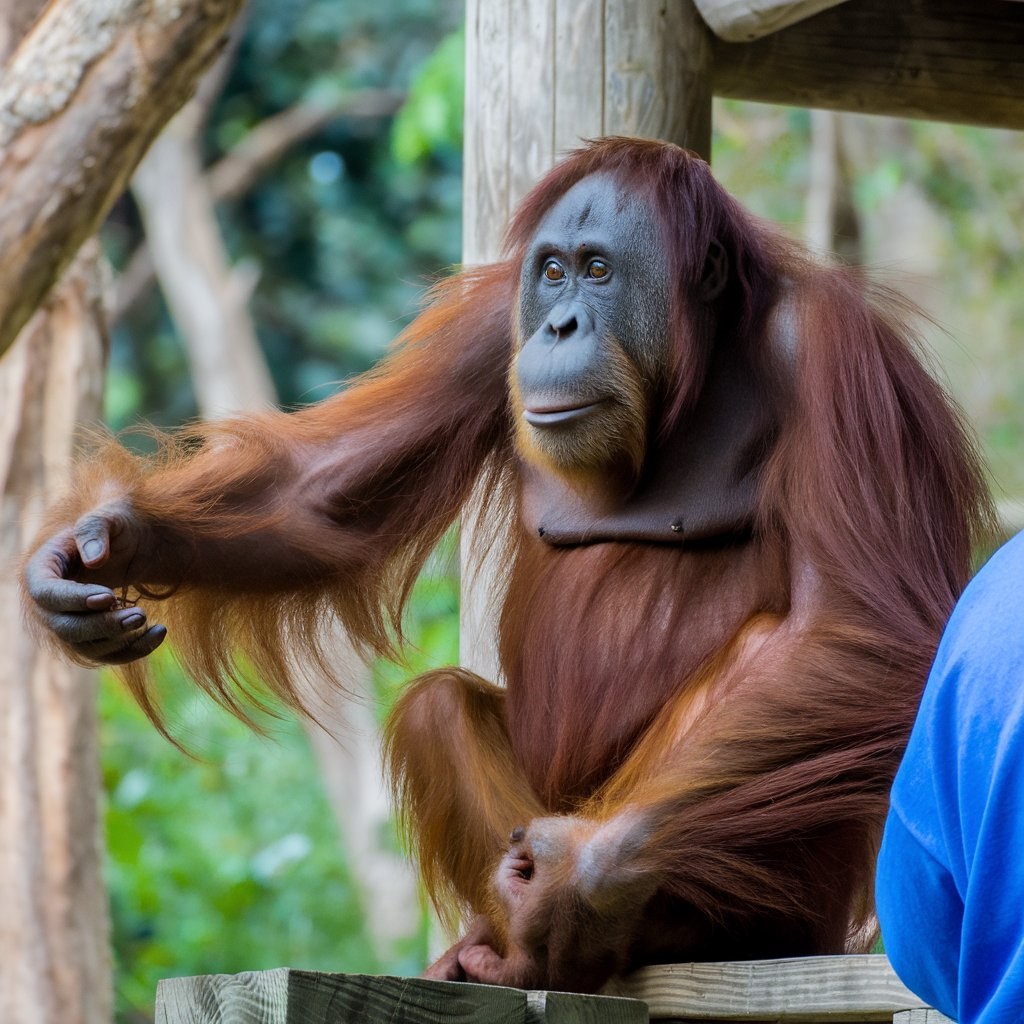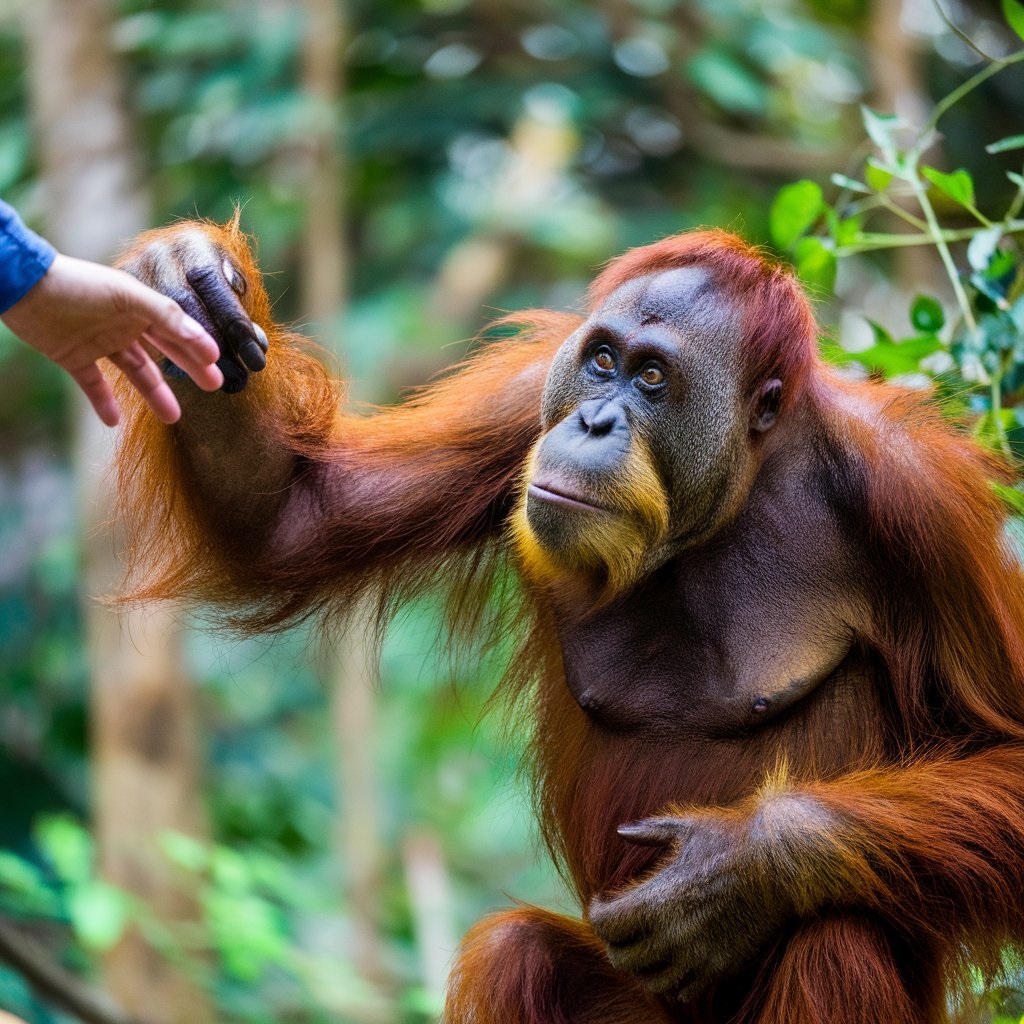Orangutans are iconic creatures of the rainforests, often admired for their intelligence, solitary nature, and exceptional adaptability. However, a common question that many people have is, do orangutans attack humans? The answer is more nuanced than a simple yes or no.
While orangutans are not typically aggressive, there are certain circumstances where aggression might occur. This article will provide a detailed look at orangutan behavior, the myths surrounding their interactions with humans, and the role conservation efforts play in reducing human-orangutan conflict.
Certainly! Here is a table summarizing the key facts and figures from the article:
| Topic | Fact/Figure |
|---|---|
| Species of Orangutans | 3 species: Bornean orangutan (Pongo pygmaeus), Sumatran orangutan (Pongo abelii), Tapanuli orangutan (Pongo tapanuliensis) |
| Native Habitat | Rainforests of Borneo and Sumatra, Southeast Asia |
| Conservation Status | All three species are critically endangered due to habitat loss, illegal logging, and poaching. |
| Diet | Primarily frugivorous (fruit-eating), also eat leaves, bark, and insects. |
| Life Expectancy | Wild: 30-40 years; Captivity: up to 50 years |
| Population Estimates | Bornean orangutan: ~104,700; Sumatran orangutan: ~14,000; Tapanuli orangutan: ~800 |
| Territorial Range | Male orangutans may have a home range of up to 3-4 square miles, while females have smaller territories. |
| Tool Usage | Orangutans are known to use sticks and branches to extract food, build nests, and solve problems. |
| Average Size | Weight: Males 100-200 lbs, Females 70-110 lbs; Height: 4-5 feet tall (standing). |
| Aggression Triggers | Territorial encroachment, maternal protection, captivity stress, fear, and past trauma |
| Typical Behavior | Solitary, highly intelligent, use of tools, strong cognitive function, arboreal lifestyle. |
| Conservation Organizations | Borneo Orangutan Survival Foundation, Orangutan Foundation International, Sumatran Orangutan Conservation Programme |
| Habitat Loss | 80% of orangutan habitat has been lost in the past 20 years due to deforestation, palm oil plantations, and illegal logging. |
| Reforestation Projects | Reforestation efforts in Borneo and Sumatra are helping to restore orangutan habitats and protect their future. |
| Wildlife Corridors | Wildlife corridors are being developed to help orangutans move safely between fragmented habitats. |
| Sustainable Palm Oil Support | Choose products with Certified Sustainable Palm Oil (CSPO) to help protect orangutan habitats. |
What Are Orangutans?
An Overview of Orangutans
Orangutans are large, arboreal primates found in the rainforests of Borneo and Sumatra, which are located in Southeast Asia. They are one of the most distinctive members of the great ape family, along with gorillas, chimpanzees, and bonobos. There are three species of orangutans: the Bornean orangutan (Pongo pygmaeus), the Sumatran orangutan (Pongo abelii), and the Tapanuli orangutan (Pongo tapanuliensis), which is the most recently recognized species.
These primates are equipped with long, powerful arms that help them swing through the trees. They are highly adapted to arboreal life and spend the majority of their time in the trees, where they build nests, sleep, and forage for food. While they are highly social in some respects, their lifestyle is generally solitary, making them unique among other great apes like chimpanzees and gorillas, who live in larger, more complex social groups.

Cognitive Abilities and Tool Use
One of the most fascinating aspects of orangutans is their cognitive abilities. They are not just intelligent animals; they are known to use tools in their natural environment. This is one of the most significant indications of their problem-solving abilities. For instance, orangutans in the wild use sticks to extract insects or to pull down branches to reach higher fruit. In captivity, they have been observed using a variety of objects, such as stones or sticks, to accomplish tasks like opening containers or solving puzzles.
Their problem-solving skills are a hallmark of their intelligence. They also display advanced memory, which they use to navigate their territories and remember the locations of important food sources. This ability to learn from experience and pass down knowledge to younger generations is another trait that sets orangutans apart from other species.
Orangutan Behavior in the Wild
Solitary Nature and Social Interactions
Unlike many primates, orangutans are primarily solitary animals. While they may temporarily come together during the mating season, most of the time, they live alone. This solitary nature is partly due to the environment in which they live. The dense rainforests of Borneo and Sumatra provide an abundant supply of food, and there is no need for orangutans to form large social groups to survive. Instead, each individual has its own home range, and they spend most of their time alone, except when females are caring for their young.
Despite their solitary lifestyle, orangutans do have some social interactions. For example, they may come into contact with other orangutans during mating or when young orangutans are learning from their mothers. However, these interactions are usually brief and non-violent. Most of the time, orangutans maintain a peaceful distance from one another, as the territorial instincts of both males and females keep them from overlapping their ranges.
Behavior and Communication
Orangutans communicate with each other primarily through non-verbal cues and vocalizations. Their vocalizations include sounds such as the “kiss squeak” made by infants and mothers, which can also be heard when orangutans are excited or trying to get someone’s attention. The orangutan call can carry across long distances through the dense forest, helping to communicate the presence of an orangutan to others, or simply express the animal’s emotional state.
The body language of orangutans is equally complex. For example, when an orangutan feels threatened or cornered, it may display an intimidating posture, puffing out its chest or showing its teeth as a sign of aggression. However, in most cases, orangutans are not prone to attacking others; rather, they will use these behaviors to warn others of their presence or to signal discomfort.
Do Orangutans Attack Humans?
Rare Instances of Aggression
The image of a violent orangutan attack on humans is more of a myth than a reality. Orangutans are generally non-aggressive and, by nature, tend to avoid conflict. However, there have been rare instances where orangutans have exhibited aggression, typically due to stress, fear, or territorial defense.
These instances are incredibly rare and typically occur when the orangutan feels threatened or is protecting its young. Aggressive behavior often arises when an orangutan is forced into close proximity with humans or other animals. Wild orangutans rarely come into direct conflict with humans because they naturally avoid them. However, as orangutans are increasingly driven out of their natural habitats due to deforestation and habitat destruction, human-orangutan interactions are becoming more frequent. This increased contact can lead to misunderstandings and, in rare cases, aggression.

Common Triggers for Aggression
Aggression in orangutans is most often triggered by the following factors:
- Territorial Encroachment: Orangutans are fiercely territorial creatures. In the wild, they mark their territory with vocalizations and physical markings. When their territory is threatened—especially by humans encroaching into their habitats—orangutans may become defensive and act aggressively to protect their space.
- Stress in Captivity: Orangutans kept in captivity or rehabilitation centers are more likely to show aggressive behavior due to the unnatural environment. Stress caused by confinement, lack of stimulation, and inadequate space can lead to frustration and anxiety, which may result in outbursts of aggression. In addition, many orangutans in captivity have experienced trauma, which can also trigger defensive aggression.
- Maternal Instincts: Female orangutans are extremely protective of their young. If a mother feels that her baby is threatened, either by a human or another animal, she will act aggressively to defend her child. This is a natural behavior seen in many species, including humans.
- Fear and Confusion: If an orangutan feels cornered or is caught in an unfamiliar situation, it may act out of fear. For example, an orangutan that has been separated from its group or its habitat might feel scared and attack in self-defense. Similarly, orangutans that have been kept as pets or in illegal wildlife trade are often subjected to trauma and abuse, which can lead to unpredictable and aggressive behavior.
Human-Orangutan Interaction
Wild Encounters
In the wild, human-orangutan encounters are usually peaceful and rare. Orangutans are shy and avoid humans whenever possible. However, due to the encroachment of human settlements and deforestation, orangutans are increasingly found in proximity to human-populated areas. Rainforest destruction, illegal logging, and the expansion of palm oil plantations have caused orangutans to migrate out of their natural habitats, leading to more frequent interactions with humans.
In these encounters, orangutans are more likely to retreat than engage in conflict. They will climb to higher branches or move into the forest to escape danger. However, if humans approach too closely, especially when provoking or disturbing the animal, an orangutan may become defensive. Understanding orangutan behavior and giving them space is crucial for preventing conflicts. It is vital to maintain a safe distance from wild orangutans and avoid any actions that might be perceived as a threat.
Sanctuary and Captivity Interactions
Sanctuaries and rehabilitation centers provide an opportunity for orangutans to recover from past trauma, and they also serve as a way for humans to interact with these incredible animals in a controlled, safe environment. However, even in captivity, the possibility of aggression exists if the orangutan feels stressed or threatened.
Captivity stress can lead to behavioral problems in orangutans, including aggression. The confinement of space, lack of privacy, and absence of natural stimuli can create anxiety and frustration in orangutans, prompting them to lash out. However, with proper care and management, such incidents can be minimized. Zoos and sanctuaries use enrichment programs to provide mental stimulation and keep orangutans engaged, helping reduce stress and aggression.
Conservation Efforts and the Role of Habitat Protection
Reducing Human-Orangutan Conflicts
As human activity continues to encroach on orangutan habitats, human-orangutan conflicts are on the rise. Deforestation, illegal logging, and agricultural expansion are driving orangutans from their natural homes, increasing the likelihood of conflicts with humans. Conservation efforts play a crucial role in reducing these conflicts by focusing on habitat protection, restoration, and sustainable practices.
Key conservation strategies include:
- Habitat Protection: Creating protected areas and national parks in areas where orangutans live helps safeguard their environment. This ensures that orangutans can roam freely without the risk of human intervention. Conservationists are also working to protect rainforest ecosystems from deforestation and illegal logging.
- Reforestation Projects: In areas where forests have been destroyed, conservation organizations are working to restore orangutan habitats through reforestation. Planting native trees helps rebuild the orangutan’s natural environment, providing them with the food and shelter they need to survive.
- Wildlife Corridors: To prevent orangutans from coming into conflict with humans, wildlife corridors are being established. These protected paths allow orangutans to move safely between fragmented habitats without coming into contact with human settlements or farmland.

How You Can Help Orangutans
While conservation organizations are doing important work, there are also steps that individuals can take to support orangutan conservation:
- Support Sustainable Palm Oil: Choose products that use sustainable palm oil. Unsustainable palm oil production is a leading cause of deforestation, and by supporting ethical companies, you can help protect orangutan habitats.
- Donate to Conservation Efforts: Organizations such as the Borneo Orangutan Survival Foundation and the Orangutan Foundation International are working tirelessly to protect orangutans. Consider donating to these organizations or participating in their programs to help make a tangible difference.
- Educate Others: Spread awareness about the threats facing orangutans, including habitat destruction and the illegal pet trade. The more people who understand the importance of protecting these incredible creatures, the better the chances for their survival.
FAQs
1. Are orangutans aggressive towards humans?
Orangutans are generally peaceful, but some may show aggression if they feel threatened, especially those reintroduced into the wild after captivity. Male orangutans can also display aggression during competition for mates or territory.
2. Has an orangutan ever hurt a human?
While orangutans are not typically aggressive, they have been known to harm or even kill humans if they feel cornered or their habitat is threatened. They are strong but generally avoid confrontation unless provoked.
3. Can a human fight an orangutan?
A human would likely struggle in a physical fight with an orangutan, as they are much stronger than humans, but survival would depend on training and strategy. However, it’s important to avoid such encounters as orangutans can be unpredictable.
4. What is the most aggressive ape?
Chimpanzees are considered the most aggressive of the great apes, often engaging in territorial disputes and displaying physical strength in confrontations. They are more inclined to fight compared to other apes.
5. Can you touch an orangutan?
Orangutans should never be touched, as they are intelligent, wild animals that require respect and distance. It is crucial to observe them without physical interaction to ensure their well-being and natural behavior.
6. Is an orangutan stronger than a gorilla?
While not as strong as gorillas, orangutans are still about seven times stronger than humans, with their physical strength concentrated in their long arms and shoulders used for navigating through the trees.
7. Do orangutans bond with humans?
Orangutans raised by humans from an early age may form strong emotional bonds with them, though wild orangutans tend to be more cautious and less comfortable around people.
8. Which of the great apes are the friendliest?
Bonobos are known to be the most socially harmonious and empathetic of the great apes, often displaying kindness and cooperation with both strangers and each other, unlike other species that can be more territorial.
9. Are orangutans seven times stronger than humans?
Yes, orangutans are approximately seven times stronger than humans, especially in their upper body strength, which aids them in swinging from trees and navigating their forested environments.
10. What is an orangutan’s natural enemy?
Young orangutans face threats from predators such as clouded leopards, crocodiles, and even large birds of prey, although human activity is their greatest danger.
11. Can orangutans bite?
Yes, orangutans can bite, and their bites are powerful enough to cause harm. They are stronger than humans and may become aggressive in captivity, especially if mistreated.
12. Which ape has the highest IQ?
Orangutans are one of the most intelligent apes, surpassing even chimpanzees in certain cognitive tasks. They excel at solving problems and using tools, showcasing their advanced problem-solving skills.
13. What is the most friendly monkey?
The northern muriqui monkey is considered the most peaceful monkey species, living in cooperative societies where conflicts are rare, and social bonds are built on mutual support rather than aggression.

Final Thoughts
So, do orangutans attack humans? In most cases, the answer is no. Orangutans are not naturally aggressive, and they tend to avoid humans when given the chance. However, there are situations where an orangutan may act defensively or aggressively, often as a response to fear, stress, or territorial threats. By understanding orangutan behavior and supporting conservation efforts, we can help ensure that these magnificent animals thrive in the wild and reduce the likelihood of conflict.
Let’s work together to protect orangutans, their habitats, and the future of this critically endangered species.
Read more knowledgeable blogs on Flowy Magazine

James Clair is a passionate writer and researcher with a deep fascination for animal behavior and its intricate connection to human life. With a background in [relevant field of study, e.g., zoology, psychology, ethology], James has spent years studying the natural world, focusing on how animals’ actions and instincts impact human emotions, behavior, and society.
His expertise in [specific topics or regions of focus, e.g., canine psychology, animal communication, wildlife conservation] has led to numerous published works and collaborations with renowned researchers and institutions. Through his work at Flawy Magazine, James aims to bridge the gap between scientific research and public understanding, offering insightful, accessible articles that explore the complex relationship between humans and animals.
When he’s not writing, James enjoys [personal hobbies or interests, e.g., hiking in nature, volunteering at animal shelters, photography] and is an advocate for [cause or charity related to animals or conservation]. His mission is to inspire readers to see animals not just as companions or creatures of the wild, but as beings whose behavior holds valuable lessons for us all.









